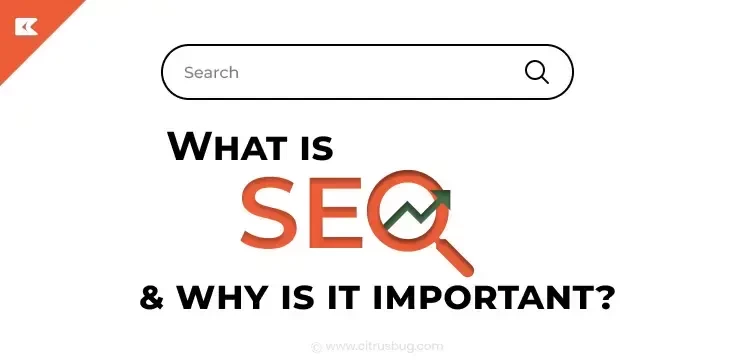
A solid online presence is crucial for businesses and individuals in the digital era. Whether you run an e-commerce store, a blog, or a professional website, the importance of search engine optimization (SEO) lies in attracting organic traffic to your platform.
Remaining current with the latest trends and adhering to best practices is crucial for success in the continuously evolving field of SEO, maintaining.
When potential customers or readers search for products, services, or information online, they are likelier to click on the top results that appear in search engines like Google, Bing, or Yahoo.
This makes website owners need to invest time and effort in optimizing their websites to achieve higher rankings.
This article will explore the ten most noteworthy SEO tips to enhance your rankings and reach a wider audience online.
By implementing these strategies, you can boost your website’s visibility, attract increased organic traffic, and ultimately achieve your online goals.
What Is SEO?

SEO, short for Search Engine Optimization, is a digital marketing strategy to enhance a website’s visibility and positioning on search engine results pages (SERPs).
Through the optimization of elements like content, keywords, meta tags, and backlinks, SEO assists search engines in understanding the site’s relevance to user queries. The ultimate goal is to attract organic (non-paid) traffic and increase the site’s chances of being found by potential visitors.
SEO practices also ensure a positive user experience, fast loading times, and mobile-friendliness. By adhering to SEO guidelines, businesses and website owners can enhance their online presence, reach their target audience, and potentially increase conversions and revenue.
It is an ever-evolving field due to changes in search engine algorithms, and its implementation Necessitates a blend of technical proficiency and strategic planning.
Implementing SEO tips effectively requires technical expertise and strategic planning to stay ahead in the digital landscape.
What Is SEO And Why Is It Important?

Search Engine Optimization, also known as SEO, enhances a website’s visibility on search engines. It fine-tunes content, structure, and keywords to rank higher in organic search results.
SEO enhances user experience, making websites more relevant and user-friendly. It increases site traffic, generating potential leads and customers. SEO analyzes search trends to optimize content strategy effectively. It aids in outperforming competitors and gaining a competitive edge.
SEO’s importance lies in driving targeted traffic and improving online presence. It fosters credibility and trust with users, leading to higher conversion rates.
SEO ensures websites align with search engine algorithms and updates. It optimizes voice search, catering to the growing trend of voice-assisted devices. SEO enhances mobile compatibility, which is crucial in the era of smartphones.
It supports local businesses by targeting geographically specific audiences. SEO empowers long-term growth and sustainable digital marketing strategies. It fosters a cost-effective marketing approach by targeting users actively seeking products or services.
SEO is pivotal for online success, visibility, and reaching the right audience. Implementing practical SEO tips can significantly improve a website’s visibility and ranking on search engine results pages (SERPs).
Top 10 SEO Tips
Here are the top 10 quick SEO tips to help improve your website’s visibility in search engine results:
Keyword Research Is Key
Before commencing the optimization of your website, comprehensive keyword research is vital. Identify pertinent and high-traffic keywords your target audience employs when searching for products or information within your niche.
Utilize keyword research tools to unveil valuable insights. Select the most suitable keywords to target throughout your content.
These targeted keywords will enhance your website’s visibility in search engine results, attracting organic traffic and potential customers.
Strategic keyword integration can improve your site’s SEO, Enhancing its likelihood of higher rankings in search engine result pages (SERPs).
Stay updated with trends and search patterns regularly to refine your keyword strategy. A well-researched keyword strategy can be the driving force behind your website’s success and online presence.
High-Quality Content
The essence of every prosperous SEO strategy is the content strategy. Search engines favor websites with valuable, informative, and well-written content.
Create compelling articles, blog posts, or landing pages that satisfy search intent and engage your audience. High-quality content encourages visitors to stay longer, reducing bounce rates and signaling value to search engines.
Incorporate relevant keywords naturally and focus on user experience to enhance SEO effectiveness. Regularly update and refresh content to maintain relevance and attract organic traffic.
Integrate multimedia elements like images and videos to enrich the user experience. Strive for authoritative and trustworthy content to build credibility and gain backlinks. Consistent production of top-notch content is critical to long-term SEO success.
On-Page Optimization
Optimize your website’s on-page elements for search engines. Optimize title tags, meta descriptions, heading tags (H1, H2, etc.), and URL structures.
Incorporate target keywords naturally, maintaining relevance and conciseness. Guarantee that search engines can comprehend your content and rank it higher.
Improve user experience with well-structured content and keyword-rich headings. Utilize descriptive meta tags to entice users and search engine crawlers. Create SEO-friendly URLs that reflect your content’s topic.
Aim for equilibrium between optimizing keywords and user readability. Regularly review and update on-page elements to adapt to changing search algorithms. Track analytics to assess the efficacy of your on-page optimization efforts.
Mobile Optimization
With most internet users accessing content on mobile devices, having a mobile-friendly website is non-negotiable.
Search engines prioritize mobile-responsive websites, and failure to cater to mobile users can result in lower rankings. Guarantee that your website is tailored for optimal performance on mobile devices and delivers a smooth user experience across different devices. Focus on fast loading times, intuitive navigation, and easy-to-read content.
Utilize responsive design elements to adapt your site to various screen sizes. Optimize images and minimize unnecessary elements to enhance mobile performance.
Periodically assess your website’s compatibility on various mobile devices to identify and resolve any issues. Invest in mobile SEO strategies to boost visibility and organic traffic.
Emphasize the importance of mobile optimization to your web development team and stay updated on best practices. A mobile-friendly website improves search rankings and enhances user satisfaction, increasing conversions and business growth success.
Page Speed Matters
Page speed is crucial for delivering a positive user experience and SEO. Slow-loading pages cause high bounce rates and harm rankings.
Optimize by compressing images, using browser caching, and employing a content delivery network (CDN) for faster content delivery worldwide.
Prioritize mobile responsiveness and minify CSS and JavaScript. Regularly monitor performance metrics and fix issues promptly. Invest in quality hosting to handle traffic spikes efficiently.
Streamline code and limit redirects to enhance loading speed. A fast-loading website enhances user satisfaction and boosts search engine visibility. Act now to optimize your site and reap the benefits.
Build High-Quality Backlinks
Building high-quality backlinks is crucial for establishing authority and credibility with search engines. Seek reputable and relevant websites to signal trustworthiness.
Use guest posting, outreach, or shareable content to attract natural links. Spammy link-building should be avoided to prevent penalties and ranking drops. Backlinks are a strong foundation for organic search traffic and improved SEO performance.
Prioritize value-driven collaborations with industry influencers and authoritative websites. Consistently monitor backlink profiles and disavow any harmful or irrelevant links.
Engage in content marketing strategies to attract organic backlinks and enhance online visibility. Dedicate time to building relationships with other website owners to earn valuable backlinks.
Utilize SEO tools to analyze competitor backlinks and uncover link-building opportunities. Stay updated with industry trends to adapt and refine your backlink strategy accordingly.
Use Descriptive Image Alt Text
Using descriptive image alt text is crucial for search engines and accessibility. Alt text provides context and relevance to visuals, benefiting visually impaired users.
It also increases the potential for image search traffic. Ensure each alt text accurately describes the image content. Avoid stuffing keywords; focus on being informative.
Utilize natural language and be concise. Consider the image’s role in the overall content to craft appropriate alt text. Meaningful alt text enhances SEO and user experience.
Remember to incorporate alternative text for decorative images to distinguish them from informative ones. Embrace alt text as an essential tool for inclusive and search-friendly content.
Leverage Social Media
Social media signals indirectly impact SEO by enhancing website visibility and driving traffic. Share content on relevant platforms to expand the reach and encourage engagement, benefiting SEO.
Engaging posts and shares create potential backlinks, positively affecting search rankings. Interacting with followers and responding to comments boosts user experience signals.
Social media profiles can also be visible in search results, improving brand presence. Utilize hashtags and keywords strategically to attract relevant audiences.
Regularly post valuable content to maintain an active online presence. Monitor social metrics to refine your strategy and identify audience preferences.
Engage with influencers to broaden your reach and enhance credibility. A solid social media presence complements SEO efforts and fosters a thriving online community.
Monitor And Analyze
Regularly track website performance and rankings via Google Analytics and Search Console. Analyze data to find areas for improvement and measure SEO success.
Understand user behavior and search patterns to refine your strategy for better results. Optimize keywords and content to enhance search visibility.
Utilize backlink analysis to strengthen domain authority. Stay updated on alterations in search engine algorithms and adjust accordingly. Monitor site speed and mobile-friendliness for optimal user experience. Implement structured data markup to enhance rich snippets in search results.
Utilize social media analytics to gauge website traffic from social platforms like Instagram and YouTube. YouTube SEO tips will also help analyze. Periodically assess and revise your SEO strategy to remain competitive.
Stay Updated With SEO Trends
SEO constantly evolves, with search engines updating algorithms frequently. Stay knowledgeable about the latest trends, updates, and best practices to stay ahead.
Constantly adjust your strategy to align with industry trends and changes and maintain ranking. Keep an eye on emerging technologies and user behavior shifts. Engage in regular keyword research to target relevant audiences effectively.
Ensure your website is tailored for optimal performance on mobile devices and voice searches to meet changing user preferences. Leverage high-quality content and backlinks to boost organic traffic and authority. Monitor analytics and performance metrics to identify areas for improvement.
Engage with the SEO community, attend conferences, and follow reputable blogs to gain insights. Embrace innovation and test new techniques to secure long-term SEO success.
SEO Strategies

SEO (Search Engine Optimization) strategies evolve constantly and Adapt to shifts in search engine algorithms and user behaviors.
Below are some top SEO strategies that were effective then, but remember that the landscape may have shifted since then.
Always consult the latest SEO best practices for the most up-to-date information:
User Experience (UX)
Prioritize an exceptional website UX. Simple navigation, prominent calls-to-action, and an automatic design foster user engagement and minimize bounce rates.
Tailor content to user needs, optimizing load times for seamless interactions. Responsive design ensures accessibility across devices, enhancing user satisfaction.
Solicit user feedback to refine and enhance the site’s performance continually. Streamline the checkout process for smoother transactions and increased conversions.
Implement personalized experiences through user accounts and preferences. A user-centric approach builds trust and fosters lasting relationships.
Regularly analyze user behavior to identify areas for improvement. Emphasize empathy and user research to craft a website that delights and retains visitors.
Optimize your content for voice search queries. Leverage the growing popularity of intelligent assistants and mobile devices to reach a wider audience.
Craft natural, conversational language in your content to align with voice search behavior. Concentrate on utilizing long-tail keywords and phrases that individuals commonly use when speaking aloud. Ensure your website’s structure is mobile-friendly and loads quickly to enhance voice search performance.
Incorporate local SEO strategies to capture location-based voice searches. Incorporate structured data markup to offer context and relevance to search engines. Consistently refresh and update your content to remain relevant in voice search results.
Monitor and analyze voice search data to refine your optimization strategy continuously. Embrace voice search as a critical aspect of modern SEO to stay ahead of the curve.
Local SEO
If you have a brick-and-mortar presence, ensure your website is optimized for local searches. Own and optimize your Google My Business listing and encourage customer reviews.
Ensure your NAP (Name, Address, Phone number) is consistent across all online Platforms. Employ location-specific keywords within your website content and meta tags. Create localized content and engage with local communities through social media.
Get listed in online directories and local citation sites. Embed a Google Map on your website for easy navigation. Improve your website’s loading speed and mobile responsiveness.
Implement structured data markup to enhance search results. Monitor and analyze local SEO performance regularly to make necessary adjustments.
Schema Markup
Implementing it offers search engines crucial context about your content, boosting the likelihood of rich snippets in search results.
These snippets provide users with more information upfront, increasing click-through rates. Structuring data with schema markup enhances your website’s visibility and relevance to relevant queries.
This structured approach helps search engines comprehend your content’s finer details, such as ratings, reviews, and events. Consequently, your web pages may feature prominently in knowledge panels and other specialized search results.
Emphasizing schema markup also facilitates voice search optimization, benefiting from the rising popularity of virtual assistants. Elevating your SEO strategy with schema markup proves beneficial for overall search performance.
Regular Updates
Maintaining your website with regularly updated and fresh content is crucial. Regularly adding new and relevant materials sends a solid signal to search engines, indicating that your site remains active and valuable.
This, in turn, can boost your site’s visibility in search results and draw in additional organic traffic. Regular updates give visitors a reason to return, fostering engagement and loyalty.
Set up a content schedule and adhere to it to maintain a dynamic online presence. Whether through blog posts, articles, or product updates, consistent updates demonstrate your commitment to providing up-to-date information and meeting your audience’s needs.
Embrace this practice as a fundamental aspect of your digital strategy for sustainable growth and success.
Technical SEO
To ensure crawlability and indexability, fix broken links, optimize robots.txt, and manage duplicate content. Create XML sitemaps for improved search engine visibility. Next, enhance website speed and responsiveness to boost user experience and search rankings.
Implement structured data markup for better understanding by search engines. Use canonical tags to prevent content duplication issues.
Optimize meta tags and headings for targeted keywords. Leverage HTTPS for secure browsing and gain SEO advantage. Employ mobile-friendly design to cater to mobile users and enhance search engine rankings.
Conclusion
Implementing effective SEO strategies is vital for increasing your website’s visibility, driving organic traffic, and achieving your online objectives.
You can enhance your website’s rankings and reach a broader audience by conducting thorough keyword research, producing high-quality content, optimizing on-page elements, and staying abreast of SEO trends.
SEO is a continuous undertaking, and persistent efforts will result in lasting advantages for your online visibility. So, take these top 10 SEO tips and start climbing the search engine ladder to success.We hope you have understood why you should optimize your blog with some of the points highlighted. In addition, we have different SEO tricks and SEO tips you require to bring your blog to the number one spot on the table.








No Comments